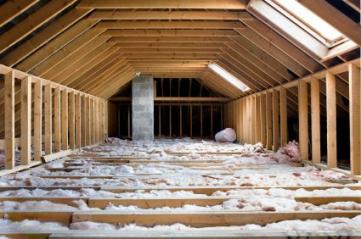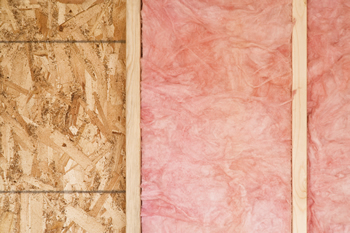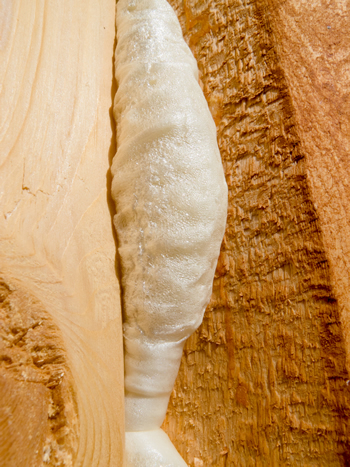
Insulation Systems
We strongly believe that this important phase in building a custom home, deserves the utmost attention, no matter what the reason behind it. Proper insulation techniques are a key factor to a quality custom home, whether the goal is "Green building" or not.
The most popular question "Which kind of insulation is best?", it is actually not an easy question to answer. The best answer we can give you is that the correct answer depends on many variables, some of which rely on "personal preference".
Over the years, we have developed a unique attitude towards insulation. We believe the insulation used in regards to your custom home plays a part in several areas.
- Critical to energy efficiency
- Critical to staying warm/cool
- Important to indoor air quality
As well as the eco-friendly topics that are now becoming important as well.
 Insulation Ratings
Insulation Ratings
Your new custom home project must follow certain building codes that are related to R-values and the minimums that are required. You may select whatever type of insulation you desire, but you must meet these code minimums.
All insulation used in American homes is rated in terms of thermal resistance, called R-value, which indicates the resistance to heat flow. The bigger the number, the better the insulation, or rather, the more effective it will be.
The R-value of thermal insulation depends on the type of material, it's thickness, and it's density. Packing two layers of insulation into an area intended for one layer will increase but not double the R-value. The addition of materials to enclosed insulation such as sheetrock and siding provides additional but typically much smaller R-value.
Insulation eliminates/reduces conduction through the insulation, and has no affect on windows and doors, thus it is important these products are of a quality nature and installed correctly.
Before we get into specific types of insulation, let's first talk about an important fact. In order to understand insulation and what works best for your project, you must understand the thermal envelope.
The Thermal Envelope
The thermal envelope is the layer that serves to maintain constant temperature levels within the home. A well maintained thermal envelope reduces energy waste and over all heating costs. The envelope does not allow cold air in or hot air out.
The building envelope is a total system of construction materials and design components that control the temperature, movement of air, and moisture both into and out of the home. The home's insulation, air barrier, and vapor barrier all need to work together to achieve a more stable, comfortable, and healthier indoor environment.
We believe that the home and its thermal envelope are greatly affected by air movement between the insulation layer in the exterior walls. The conventional "everyday" use of insulation "batts" (whether fiberglass or otherwise) allows air to pass through cavities, which dramatically reduces performance.
Reducing or eliminating air flow with the use of foam insulation can greatly increase the R-value even greater than government ratings allow. For current government ratings for insulation do not account for the affects of air movement, so a "closed cell" system will provide a greater actual R-value, when property installed.
Insulation is rated by the Department of Energy (DOE) but any claims from consumers concerning deceptive and/or misleading advertising claims is governed by the Federal Trade Commission (FTC).
 Insulation Product Types
Insulation Product Types
Blankets - Batts - Rolls
These are typically flexible products that include fiberglass, cotton or rock wool. Various widths allow for uses in walls, floors or attics. They are available with or without vapor retardant facings.
Blown-In Loose Fill
The products can be cellulose rock wool, fiberglass products that are dry or wet when installed using special pneumatic equipment. This form of insulation can be used in walls and attic floors, be used in walls and attic floors, where it is difficult for other types of insulation to be installed.
Rigid Insulation
These products are made form fibrous materials or fibrous foams and is provided in board like forms and pipe coverings. These boards can be faced with a reflective foil that reduces heat flow when next to an air space. It is often used for foundations and areas having space limitations.
Reflective-Radiant Barrier Insulation
These are products used to reduce downward heat flow and in buildings to reduce summer heat gain and winter heat loss. They are used typically between roof rafters, floor joists or wall studs.
Foam Insulation
Usually applied by a professional using special equipment. Polyicynene is an open celled foam. Polyisocyanurate, polystyrene, and polyurethane are closed cell foams. Open cell foams allows water vapor to move through the material more easily than closed cell foam. Open cell foams also have a lower R-value for a particular thickness. Compared to closed cell foams. Closed cell foams are able to provide greater R-values where space is limited, such as stud cavities in walls.
Financial Incentives for Insulation
There are numerous federal, state, and local governments that are offering out right grants or great tax incentives for the purchase of certain insulation products.
Fiberglass Insulation
Fiberglass insulation is the most widely used insulation in America today. Fiberglass insulation comes in batts, loose fill forms, and blankets. It is similar in structure to asbestos, but not really harmful, and it is still the cheapest choice in today's market, despite having the following negative issues.
- Made of tiny little fibers that raise multiple health concerns
- Installers must wear duty clothes, gloves, and a face mask
- Tiny particles can break off into the air, effecting skin, eyes and lungs
 Spray Foam Insulation
Spray Foam Insulation
There are several varieties of spray foam insulation products, and all of them are quite interesting. They start out in liquid form and are sprayed in place with professional equipment that causes the product to expand and solidify almost instantly. These high tech foams fill small cracks and crevices and when combines with a membrane covering, closed cell sprayed foams will remain water tight and structurally sound.
Some of the benefits are:
- Higher R-values
- Superior in stopping air & moisture infiltration
- Saves on energy costs
- Adds strength to the building structure
- Helps reduce moisture and mold
- Deadens sound travel and noise
- Reduces wear and tear on HVAC equipment
The most common spray foam insulation materials are:
- Polystyrene - Closed Cell
- Polyisocyanurate - Closed Cell
- Polyurethane - Closed Cell
- Polyicynene - Open Cell
These spray foam insulations are derived from chemicals distilled from petroleum, but are still considered "Green products" based on their performances capabilities overall within the home.
There are other supposed "Green products" that are soy oil based and are spray foams but they only contain a very small percentage of soy oil, and they do not insulate as well as the other foams listed above. Soy oil based spray foams perform much better than fiberglass but they are no comparison to a closed cell poly foam.
Closed cell spray foams are superior to open cell spray foams in many ways, as they stronger, have greater R-values, and greater power/strength in stopping air and moisture infiltration. It can also be applied in a manner that is almost waterproof.
We believe that a home should be allowed to breathe and ventilate but we are also familiar with modern materials and technologies that produce amazing results. Why rely on gaps and holes in your home for passive ventilation, when you can build a tight home, healthy and energy efficient, and let the mechanical ventilation systems do their jobs.
We believe that the superior insulation system uses a 2.0 lb/cu. ft. closed cell spray foam that will give you the highest R-value rating possible. This system will provide you with a more comfortable home that is less expensive to heat and cool, along with many other unique benefits. Yes, this is probably a system costing 2-3 times that of conventional fiberglass systems but the costs can be recovered in energy savings.
Click on these individual sites to learn more about the various spray foam insulations and how they can benefit your new custom home project.
www.sprayfoam.com/spps/ahpg.cfm?spgid=1
www.sprayfoam.org/
www.wisegeek.com/what-is-spray-foam-insulation.htm
Other Insulation Alternatives
There are various other alternatives to insulating your new custom home, none of which stand up to spray foams and most of these are very cost prohibitive or just plain too out of the ordinary. Most of these are unfaced so a separate vapor barriers must be installed.
- Vermiculite - Loose Fill
- Wood Chips - Loose Fill
- Rock and Slag Wool - Batts & Loose Fill
- Cementious Foam
- Cellulose - Loose Fill or Wet Spray
- Cotton Batts - Recycled Blue Jeans
- Straw Bales
- Cardboard
- Sheeps Wool - Batts


